
Pacífico Task Force Alliance and a differential approach to combatting the pandemic in the Colombian Pacific
Interview with Lizeth Sinisterra Ossa
By Maryuri Mora Grisales
The Afrodescendent population in the Colombian Pacific is one of the most vulnerable in the country. The Covid-19 pandemic not only exacerbated inequality in the region, but also exposed structural racism and the negligence of the state in guaranteeing the rights of these communities. The lack of medical and health personnel and the absence of infrastructure with enough capacity to handle health issues increased the risks and the negative outcomes of the pandemic.
In an interview with Conectas Human Rights, Lizeth Sinisterra Ossa, researcher at the Centro de Estudios Afrodiaspóricos (CEAF) of the Icesi University in Cali and manager of the Pacífico Task Force11. For more information on this project, go to: Pacífico Task Force, home page, 2021, accessed December 16, 2021, https://pacificotaskforce.com/, talked about the founding of the Alliance and all the community coordination work carried out in the past year along the Pacific Coast. She explained how a critical analysis of the situation in the Colombian Pacific and a more nuanced understanding of the different impacts of the crisis triggered by the Covid-19 pandemic on the people of African descent served as a basis for the design of the project. Lizeth also describes the challenges of working in the territory, the importance of maintaining dialogue in the community and the effort to produce long-term effects.
The interview describes the strategic lines of work that guided the project’s actions and helped strengthen the community’s capacities in detail. It also discusses the impacts of the well-coordinated collective efforts involving different actors at the local and national level to effectively combat the pandemic by and for the region.
Sur Journal • What is the Pacífico Task Force Alliance and how was it started?
Lizeth Sinisterra Ossa • This alliance emerged last year [2020] because of an underlying concern of Afrodescendent organizations and movements about the negative impacts that the pandemic would bring to the region.
There is a historical pattern of structural racism in the country, which allows people to go on affirming that some lives matter and others don’t. The pandemic came and exposed the fragility and the incompetence of the Colombian socioeconomic and political system to protect the lives of Afrodescendent communities. The vulnerabilities of these communities existed before the crisis and so, what the pandemic did was exacerbate these injustices. For example, indicators always show a higher poverty rate for this population than for the rest of the country: the multidimensional poverty rate for the black, Afro-Colombian, Palenquera and Raizal (NARP) population stood at 30.6%, 11.0 pp above the national poverty rate, which was 19.6%, according to the Departamento Administrativo Nacional de Estadística (DANE), in 2018.
If we look at the indicators for the Afrodescendent population in Colombia versus the ones for the population that does not belong to an ethnic group, we see that 81% of people of African descent work in the informal sector. We also find a high rate of barriers to access to health, water and sanitation services, which means they do not have access to water as a fundamental right, nor to be able to cope with the pandemic. How are people supposed to wash their hands regularly to prevent infection in places where there is no water?
In the analysis we carried out using the Epidemiological Intelligence System, we came up with some important findings: people of African descent are 21% more likely to be hospitalized, 88% more likely to end up in intensive care units and 24% more likely to die in comparison to the population that does not belong to an ethnic group in our country. Therefore, we need to understand the pandemic’s impact on these bodies and, above all, create policies that guarantee life, policies for care and self-care in the community.
Based on this initial concern, we came up with a strategy capable of rapidly responding to the impacts that were being identified and were going to get worse. That is how this alliance was born – as an exercise of discussion, reflection and rigorous and critical analysis of the [Pacific] region, which was meant to serve as the basis for a collective work plan. What we do here is coordinate multiple academic, research, community and territorial – and even institutional – efforts to combat the pandemic using a differential approach.
This is how important organizations in the Afrodescendent movement in Colombia such as Centro de Estudios Afrodiaspóricos (CEAF) of the Icesi University, Consejo Nacional de Paz Afrocolombiano (CONPA), Proceso de Comunidades Negras (PCN) and Comité del Paro Cívico de Buenaventura began to coordinate their efforts. These organizations have had not only a territorial but also a political impact on this country. By bringing all these forces together, we were able to continue responding to the current context that the pandemic generates.
Sur • What does this differential approach consist of?
LSO • This differential approach is central and cross-cutting to our entire process – especially the principle of the African Ubuntu philosophy. Pacífico Task Force is, “I am because we are”. Precisely because it is collaborative, collective and participative work, whose main goal is to resolve the impacts imposed on racialized and impoverished bodies, lives and territories located mainly in the Colombian Pacific region.
This differential approach has guided our processes to support the communities we have prioritized. We created methodologies and courses of action that take into account the particularities of the territories and their inhabitants. This gives us a more contextual and grounded view to provide more appropriate support that is better adapted to their reality. Based on this, we vindicated and recognized the knowledge and ancestral traditions of our peoples.
It is no secret that when states respond to this type of emergency situation, they adopt homogenous policies and guidelines that do not take the specificities of the territories into consideration, and this is precisely our concern.
For example, when the pandemic hit, the instructions from the Ministry of National Education were, “girls and boys, go home and we will all work online”. In Timbiquí, a municipality on the Pacific Coast near Cauca, only 0.9% of the population has access to the internet. Not only do the students lack access to the internet and technological resources, but their professors too, as they do not have computers or the possibility of connecting to the web. In these territories, one must buy a “pin” [prepared wireless internet services], but you either connect to the internet or you buy rice. A pin can cost 2000 pesos and last half an hour max.
In this case, our differential approach and intersectional perspective consist of putting things in context and responding according to this context, not from the outside but from within. This is why it is important.
Sur • The Alliance has five strategic lines of work. We’d like you to tell us about them. Which ones were you more successful or faced more challenges in?
LSO • Each line had interrelated goals and objectives. What is the first thing to explode in a pandemic? Hunger. These are people who work on the street and so, we first had to focus on food security. In this line of work, we wanted to support families who didn’t have enough resources to guarantee their daily food intake. The Departamento Administrativo Nacional de Estadísticas (DANE) has shown how food insecurity has gotten worse. Families who before ate twice a day were no longer eating anything or were eating only once a day during the pandemic. This is shocking and it is the result of this situation. This line of work was successful, but we also had to face challenges and vicissitudes.
We knew we had to support the communities by guaranteeing a minimum amount of food but at the same time, we noticed that the local economy was being affected – especially Afrodescendent women from the market squares who constantly had to throw away their products or give them away. They themselves told us that they would leave very early in the morning and go home late at night with only $10,000 or $20,000 pesos [3 to 6 dollars] after a long, hard day to sustain not only their children, but also their grandchildren.
We began observing this because we had established closer ties with the people from the territories. We realized that a lot of goods coming into these areas were being bought from big supermarket chains located outside the territories. In response to this, we launched a call to reinforce the idea that it’s not necessary to go elsewhere to buy things when the people from the territory have products and produce things. We also decided to draft some nutritional guidelines based on what people eat in their territories. For example, we didn’t take beans to Tumaco because they’re not part of their regular diet.
What we did with social leaders was design nutritional recommendations tailored to the territories and their eating habits. So, we initiated a process of drafting the profiles of the families we should prioritize. We carried out participatory exercises with the people from the territories to strengthen the strategy’s impact. We both donated food and gave economic security to the women in the market squares, who ranged from 30 to 60 or 70 years of age, approximately. We thus made markets with an ethnic-territorial focus viable.
Secondly, we managed to start another process in the area of health and hygiene. This issue was very problematic because most institutions and other sectors were generating a very Western view of the pandemic, which used very technical language and information that was hard for people in the territories to understand. There was a fight to give priority to Western medicine and not recognize traditional medicine. But if you ask people from the Pacific region how they survived in this context, there is no doubt that they will say that traditional medicine kept them alive. Traditional medicine has played a leading role in keeping these people alive, even more so in the context of a pandemic. For the communities of the Pacific, if the virus attacks the respiratory system, they use ginger or ‘Mata ratón’ (the ‘rat killer’ plant)22. Its scientific name is Gliricidia sepium and this species has multiple uses in Central America and South America. Popularly known as “Mata Ratón”, the leaves of this tree are commonly used in the Colombian Pacific. It has a wide range of uses for medicinal purposes, such as the treatment of skin problems, to lower fever, relieve headaches and sore throats, and cool the body down. to reinforce the immune system. And some products really did work and gradually allowed people to be cared for.
In this line on health and hygiene, we decided not to separate the West on one side and traditional medicine on the other. On the contrary, we thought of ways to strengthen community health agents so they could take a differential approach to caring for people with Covid-19. So, we initiated a dialogue between health authorities and ethnic-territorial and organizational authorities, especially the ones who are members of the community councils, to make an impact based on dialogue.
We designed Covid-19 care and prevention protocols based on a differential approach, which took the communities’ traditional medicine and knowledge into account. We generated information and educational campaigns to promote self-care, including hygiene kits, but not only with masks, alcohol and soap. People would say to us, “and where are the traditional herbs?” We designed some kits using traditional medicine, including herbs, mata ratón, ginger and others, in order to strengthen this dialogue.
In this line of work, we also realized how important it is to help the territories connect to the rest of the world. In general, the territories are isolated because they lack technological resources or communication channels that enable them to find out what is going on with the pandemic. Access to information in the country is also a privilege. We installed what we call a sound broadcasting system (an antenna with a signal) to connect the territories in Timbiquí. This pilot experiment allowed the community to have regular access to information on what was happening during the pandemic. This was also very successful.
We were also concerned with the way the state was producing information on the pandemic. We noticed that the ethnic-racial and territorial aspect was not central in the understanding of the different impacts in each territory. Based on this gap, we designed an epidemiological intelligence system – the third line of action – conceived to improve the institutions and organizations’ capacity to respond based on useful, timely, accurate, contextual, factual and pertinent information that would enable them to make decisions in line with reality.
This was a very interesting line of work because here, the health departments coordinated efforts with Yoseth Ariza-Araujo, epidemiologist and professor of the Public Health and Community Medicine Department of the Icesi University, who led the strategy. Meetings were organized to produce knowledge on this ethnic-racial variable for the territories and we produced a control panel to monitor the impacts of Covid-19 in the region.
We created spaces to strengthen the dialogue of knowledge and promoted meetings with specialists in this field. We drafted georeferencing maps together with the health departments and a team we hired to support and monitor the collection of information. The pandemic is, in a way, sectoral and localized. In Quibdó, for example, there are places where the rate of infection and even deaths is more alarming than in other sectors. This is key for responding more effectively.
In this line, we also designed a training school for boat operators, traffic police, for river, land and maritime transport. We created training programmes where we worked with the departments of transport and tourism so that boat operators and other workers from the transportation sector had the bases they needed to continue contributing to the local economy while taking care and self-care into consideration.
Finally, there is the line on education. In education, we started by engaging in an initial dialogue with education departments and local organizations to understand how to design an educational strategy in which working online was not an option. We developed two processes. One was called “Weaving Lessons Learned”: with the support of volunteers from various parts of Colombia and other Latin American countries, we offered distance learning via telephone calls. Volunteers would call a boy, a girl, a teenager or youth on the phone to help them with their lessons. We offered tutoring in mathematics, social sciences, languages. We also offered psychosocial assistance because the number of cases of suicide and violence was on the rise and so, we felt that psychosocial support should be a cross-cutting element in the process. We created an entire strategy, with protocols, that allowed us to reach 130 boys, girls, adolescents and youth in 7 territories in the Pacific.
We also worked with the Centro Eduteka of the Icesi University to design a course called “Designing learning experiences for distance education”. The goal was to strengthen teachers’ abilities and skills to make the transition and give them tools that are useful for assisting students from a distance. During the first phase, teachers reviewed their current teaching practices and learned how to redesign teaching activities so they could be offered remotely, which channels they could use and how to guide interaction with their students. During the second phase, the teachers initiated a process of multiplying and transferring knowledge to other colleagues so that they too could continue supporting their students’ learning process from a distance. In other words, they were trained to convert knowledge into a network of learning capable of reaching many places in the Colombia Pacific. Ninety-one teachers from 7 territories in the Pacific graduated from this course. Successful cases have emerged from this.33. The national press featured the story of Jenner Ruíz, a teacher from Timbiquí. This teacher prepared his classes as podcasts, put a loudspeaker on the back of a motorcycle and began going around, playing the podcasts as a way of getting the information to his students in not only urban, but also rural areas. See: "Jenner Ruiz, historia de vida", YouTube video, 11:31, published by Redes Pacífico Task Force, December 26, 2020, accessed December 16, 2021, https://www.youtube.com/watch?v=X2WWJsdKJgo&t=3s.
In addition to education, we thought of the importance of social leaders, as in the end, they are the ones who sustain life in the midst of death. In such a devastating and distressing context, there was a need to strengthen social leadership, leaders, ethnic-territorial authorities so they could adapt and offer support to the rest of the communities. Community Adaptability was thus the way forward. In this line of action, we recognized that Covid-19 was not going to disappear and so, we had to adapt and build capacity in the territory and strengthen the communities so that they could pursue their process and continue building their strength on their own. Thus, this line of work designed a training and capacity-building strategy for ethnic-territorial leaders and authorities so they can learn to adapt their organizational skills to circumstances that generate emergencies like the one caused by Covid-19. The exercise on adaptability was designed to ensure that leaders had the capacity to propose and develop leadership strategies that give assertive and timely answers to emergency and crisis situations that appear in the region. Therefore, the “Innovation for Problem Solving” course was held and 36 leaders from four territories of the Pacific region graduated from it.
All in all, we can say that everything we did was successful. It was a chain reaction: one line complemented another. As for the challenges and difficulties, there were many of them, especially in terms of intervening in a new context. To intervene, we had to interact, move, and approach people. But in the context of the pandemic, going out or holding a meeting could mean death itself. We had to develop a method to overcome these challenges. What we did was generate processes to connect and coordinate with social and community leaders who accompanied us in the territories from the beginning – from the planning to the implementation of the process.
Sur • What shaped the Alliance’s capacity to respond to Covid-19 in the Colombian Pacific and what impact did this work have in the territories?
LSO • What determined our response capacity was our analysis of the region and discussions with different actors. We met with municipal authorities, with social leaders and we also held meetings with other sectors which enabled us to carry out an in-depth analysis and based on it, generate the proposal that I have been presenting here.
We managed to do all this in a year. We started in May 2020, and we completed the first phase in May 2021. In relation to the impacts, I would summarize them like this: Pacifico Task Force generated and consolidated a coordinated, collaborative and participatory effort between local government, social leaders, ethnic-territorial leaders and other key actors. We generated a regional ecosystem of work by and for the region:
Sur • After all the work that has been done, what do you think should be the focus of attention to strengthen the most vulnerable communities of the Colombian Pacific? And what are the challenges ahead?
LSO • Everything is cross-cutting. Therefore, the focus of attention should be comprehensive, covering all fundamental rights that human beings must be able to enjoy to guarantee their existence. If one analyses the region and thinks from a rights perspective, I ask myself, “what rights do Afrodescendent communities in Colombia really have when they have to fight for the right to live?”77. A recent World Bank report affirms that Colombia is the second most unequal country in Latin America and the black population will continue to be affected. See: "Colombia, el segundo país más desigual en América Latina", Portafolio, October 27, 2021, accessed December 16, 2021, https://www.portafolio.co/economia/gobierno/colombia-es-el-segundo-pais-mas-desigual-de-america-latina-segun-el-banco-mundial-557830.
The question should be on how we strengthen the communities not only in relation to infrastructure, but also in their capacity to deal with emergencies. We need to think of strengthening them materially but also of reinforcing the installed capacity in the communities, leaving processes that enable them to adapt and respond to this situation.
How do we strengthen different forms of autonomy? How do we strengthen territorial and food sovereignty? How do we continue strengthening the analysis of the territory, the production of data and information that enable us to understand how the communities are doing? How do we generate processes of natural resource management, self-management? How do we break away from this predatory and developmentalist model?
Covid-19 is showing us that the world needs to change, but especially for those who have been denied access to a just and equitable world for over 500 years. If Colombia does not find some way to solve this situation, I don’t know where the Afrodescendent population in this country will be a few years from now, to be quite honest.
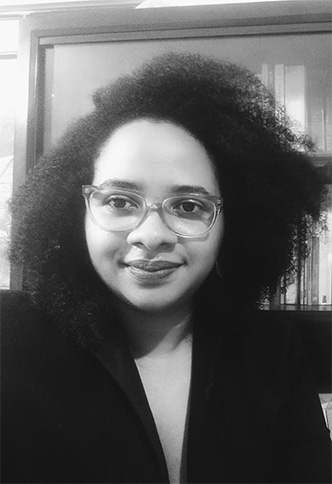
Photo from Lizeth Sinisterra’s personal collection.
About the future and the challenges, we are currently thinking about a second phase of Pacífico Task Force, thinking about how to give continuity to the work. One of the challenges we face, which is sometimes invisible, is climate change. We feel it is important to link climate change to racial justice; this connection has to be made. We are thinking of two processes for the project’s next phase: recovery from Covid-19 and natural resource protection and climate change mitigation.
The impact that climate change is leaving in Haiti or San Andrés, for example, is not without cost, and what is historically building up in the Pacific will have consequences. Therefore, the communities also have to adapt to that. It is important to affirm that the fight against climate change must also have a differential approach; climate impacts affect people and places differently. It is about building a process of accompaniment and managing change. Change is more gradual and so, it will be necessary to think about how to start the second phase based on the lessons learned to continue on the path together.
***
Interview conducted by Maryuri Mora Grisales in November 2021.
Original in Spanish. Translated by Karen Lang.
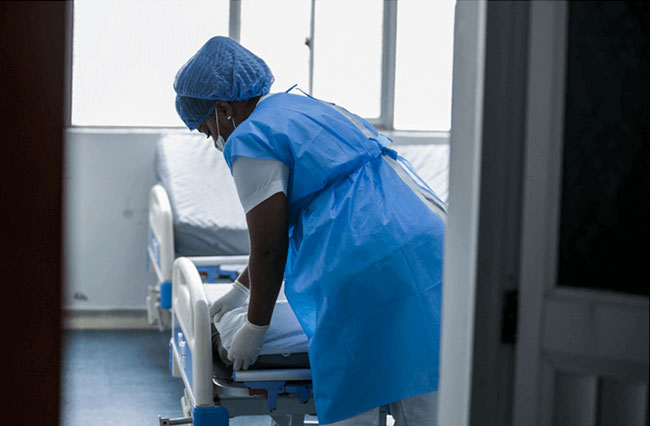
Health worker. Quibdó-Chocó.
Credits: El Murcy- Jeison Riascos
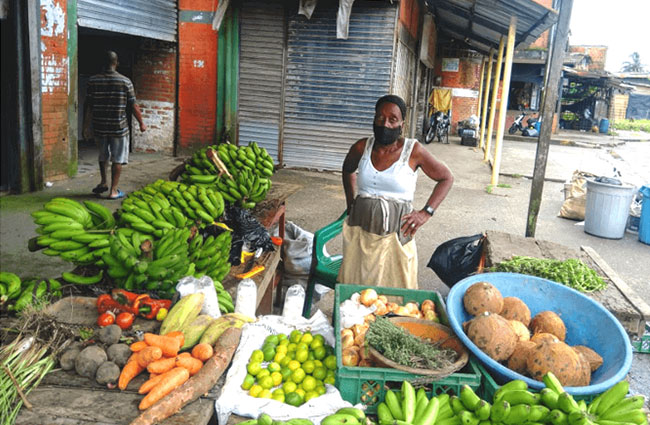
Woman at her fruit and vegetable stand in the Buenaventura Gallery – Cauca Valley, 2020.
Credits: Pacífico Task Force
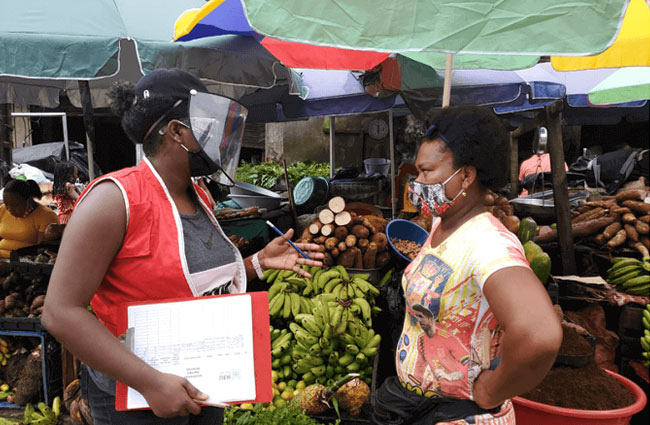
Territorial coordinator of Pacífico Task Force conducting an interview with a worker at the Quibdó-Chocó gallery, 2020.
Credits: Pacífico Task Force
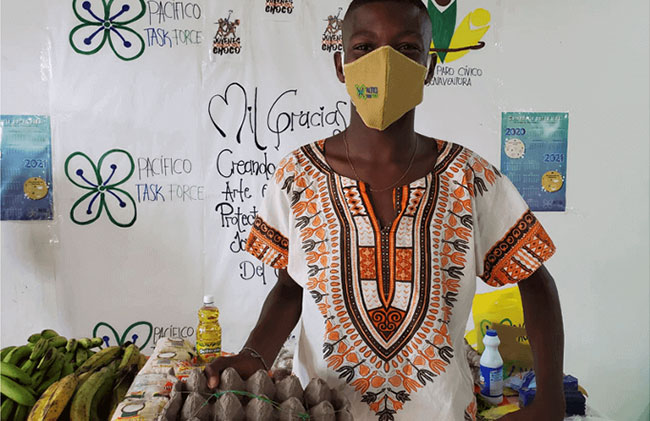
Delivery of products and hygiene and self-care kits to Jóvenes Creadores del Chocó, 2020.
Credits: Pacífico Task Force
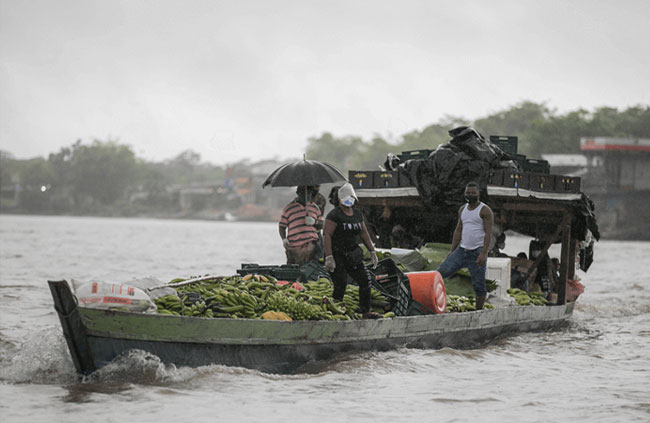
Boat people transporting people and a load of bananas in Chocó.
Credits: El Murcy- Jeison Riascos